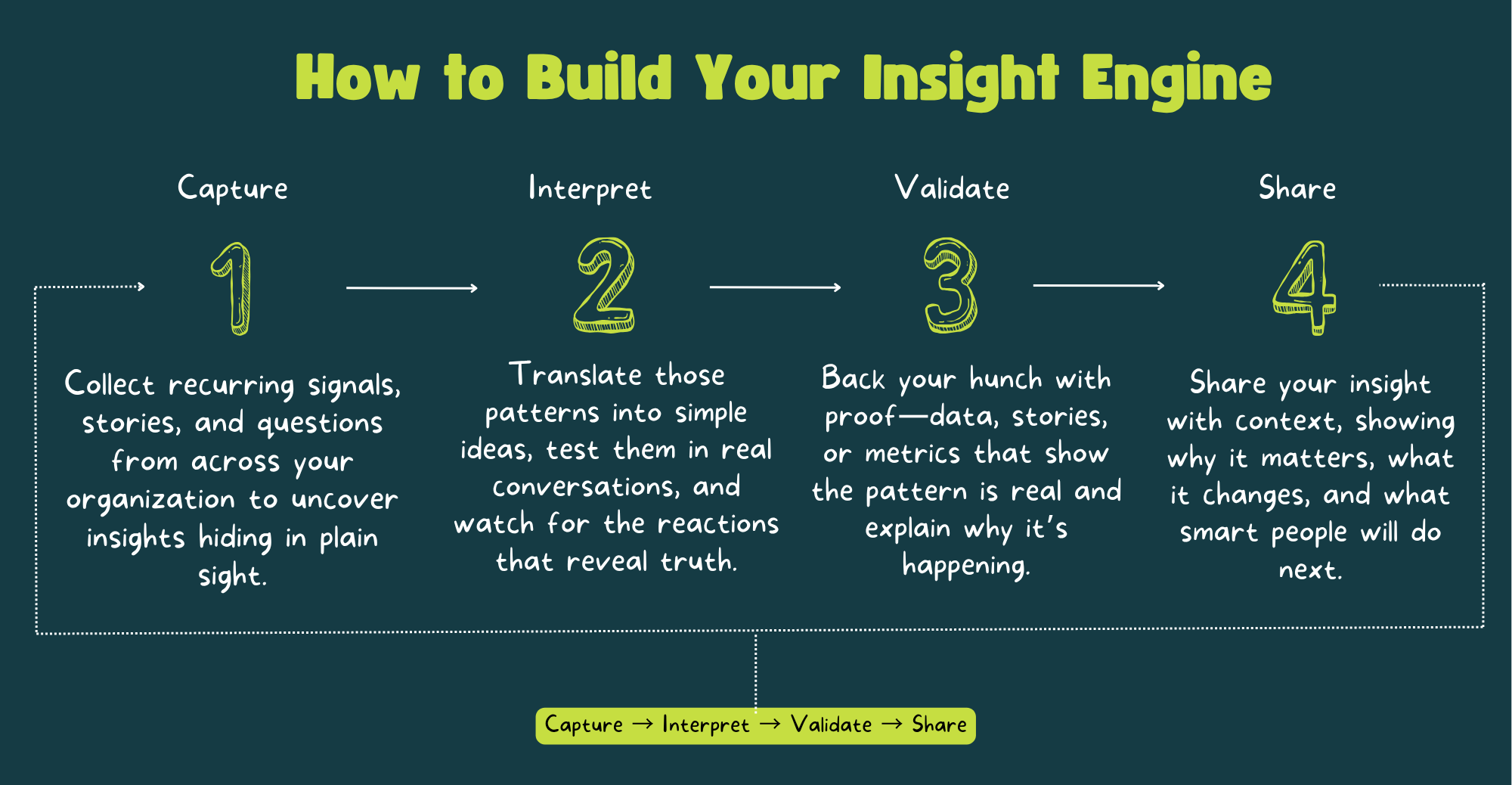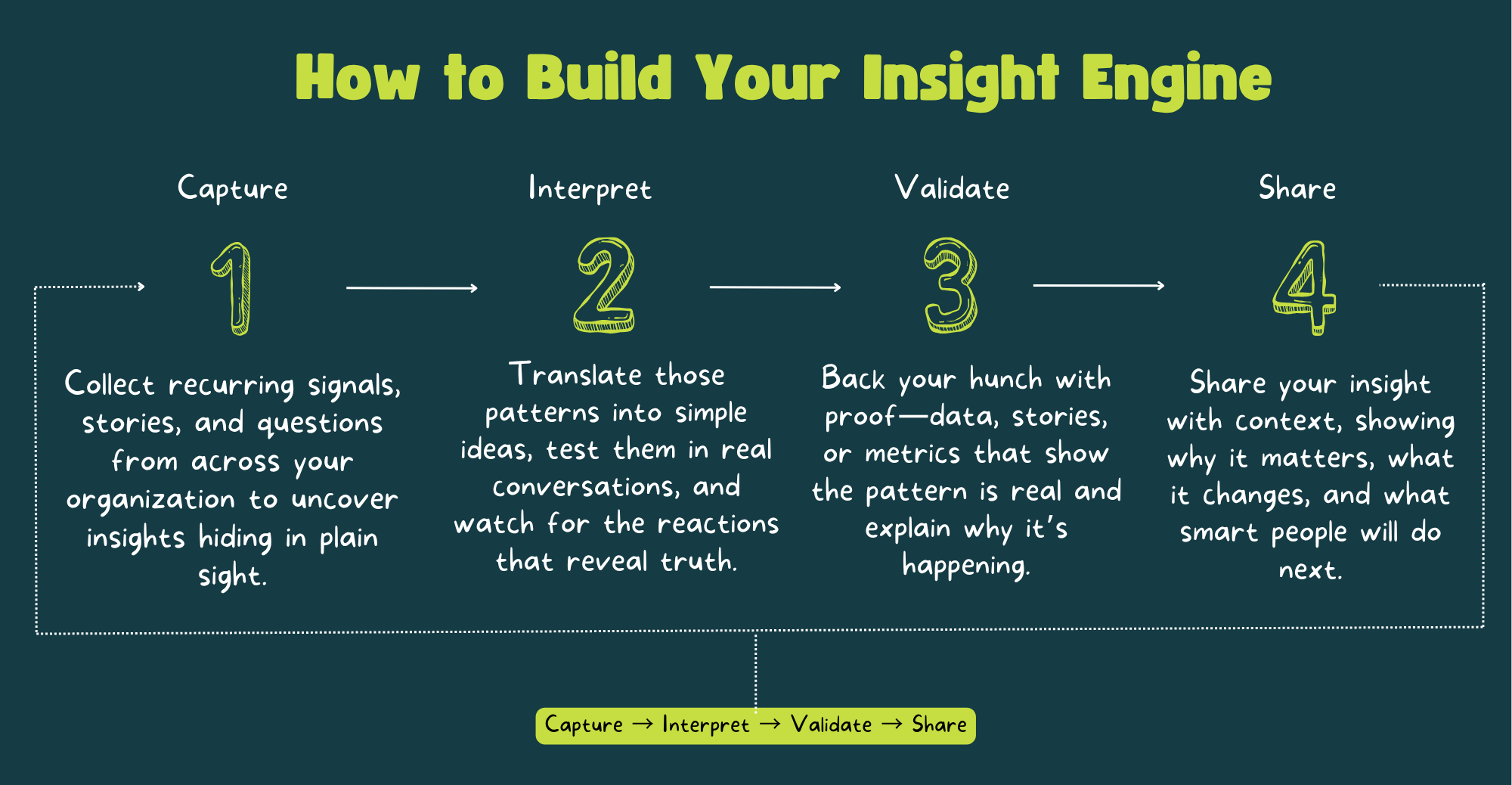There’s a difference between knowing what’s happening in your industry and understanding the story it’s really telling.
Most people do the first part well.
They track the headlines, skim the reports, and share the takeaways. (It’s easy to feel informed when your feed is full of “insights.”)
The second part takes a little more curiosity.
It’s the ability to zoom out, connect dots, and say, “Wait…something’s shifting here.”
That’s where real thought leadership begins.
Unfortunately, most of what passes for “thought leadership” today misses that mark.
Nearly half of buyers—47%—say most thought leadership doesn’t seem to be created with their specific needs in mind. (Edelman–LinkedIn B2B Thought Leadership Impact Report)
It’s built on borrowed ideas, lightly reworded and quickly forgotten. You can’t own a category if you’re quoting from it.
Spend five minutes on any feed and you’ll see it: the content echo chamber. Dozens of leaders repeating the same stats, citing the same studies, chasing the same “trends.”
It’s not laziness! It’s habit. We’re all busy, and it’s easier to react than to pause long enough to really see what’s changing.
But people remember the brand that teaches them something they didn’t know. The one that helps them see their world differently, even for a second.
And when you look closely, effective thought leadership always has three things in common:
- It’s grounded in credible evidence.
- It connects directly to what your audience is wrestling with right now.
- And it turns insight into something people can actually use.
That’s where the Insight Engine comes in.
An Insight Engine is the internal system that turns what your company is already seeing and learning into publishable thought leadership—rooted in data, customer signals, and pattern recognition. It’s the difference between reacting to the market and actually shaping it.
How to Build Your Insight Engine
Most organizations already have the ingredients for original insight, they’re just scattered across conversations, inboxes, and call notes. The challenge is recognizing what’s already there and giving it structure.
That’s what an Insight Engine does. It turns everyday signals — the questions, patterns, and shifts hiding in plain sight — into a steady source of clarity your audience can’t get anywhere else.
It starts with creating a simple, repeatable rhythm for capturing what you’re learning, and turning it into something worth sharing.
Here’s how to build yours:

Step 1: Capture What’s Already Happening
Every company is sitting on more raw insight than they realize; they just don’t have a habit of collecting it.
That’s where your Insight Engine starts.
- Listen to the frontlines. Sales, support, and implementation teams hear the earliest signs of change long before leadership does. Capture those anecdotes…even if they sound small. The moment you start hearing a phrase or frustration on repeat, that’s a clue.
- Review what’s recurring. Look at the questions customers keep asking, the issues that show up in feedback loops, and the reasons deals stall. Patterns here often reveal shifts in expectation or understanding.
- Document as you go. Don’t wait for quarterly reviews to “summarize” what you’ve learned. Keep a running log of customer language, story fragments, and internal notes. The value compounds over time.
Step 1 creates the foundation. Once observations are captured and organized, you can move from “we think” to “we know.”
Step 2: Turn Observation Into Hypothesis
Once you’ve gathered enough signals, the next step is to interpret them.
Ask simple, directional questions:
- What might this pattern be telling us?
- Is it an isolated issue or an early sign of something bigger?
- Who else might be seeing the same thing from a different angle?
Then, pressure-test the idea. Bring it into meetings, client conversations, or industry groups.
You’re checking whether the signal resonates. If people recognize what you’re describing — or push back on it — that’s good.
Indifference is what kills ideas. Tension means you’ve hit something real.
After you’ve pressure-tested the idea and it seems to hold up in conversation, it’s time to see if the data agrees.
Step 3: Validate and Strengthen
Now you’re moving from gut feel to grounded proof. It’s time to test your hypothesis with real signals.
This could mean:
- Running a short pulse survey with customers.
- Comparing internal metrics to see if behavior matches what people are saying.
- Gathering a few client stories or quotes that bring the pattern to life.
The goal here isn’t statistical perfection…it’s evidence with a story attached.
A single quote or dataset that explains why the shift is happening often carries more weight than 20 slides of numbers.
Step 4: Publish With Perspective
Once you understand what’s happening, share it (but don’t just share what you found).
Explain why it matters.
Your job isn’t to show numbers!!!! It’s to show what they mean.
When you publish, frame it through three lenses:
- Relevance – Why this matters now.
- Impact – What it changes for your audience.
- Action – What smart people will do differently because of it.
When you publish through that lens, you stop producing content and start shaping conversation.
That’s the moment research turns into thought leadership.
Turning Client Conversations Into Thought Leadership
A while back, we worked with a wealth advisory firm known for its long-term fiduciary mindset to uncover what clients truly valued about their partnership.
Their team wanted to understand what people valued most in an advisor relationship today.
So instead of relying on assumptions, we went to the source. We conducted a series of customer surveys and in-depth interviews with both long-time and newer clients.
The goal wasn’t to measure satisfaction; it was to listen for language.
Patterns started to form, not just in what clients said, but in how they said it. Their words revealed an emotional undercurrent that data alone wouldn’t have shown.
That insight became the spark for a broader evolution.
It shaped the firm’s client messaging, influenced how advisors communicated, and guided the themes behind their thought leadership.
The research became a living input for webinars, videos, and client education content that spoke to what people were genuinely feeling and needing.
Action Step: Build Your Own Insight Engine
You don’t need a complex setup. Start with a single place to capture what you’re learning and a habit of revisiting it until patterns start to appear.
Here’s how to start:
1.Pick Your Listening Zone
Choose three places where your audience “talks out loud.”
It could be LinkedIn comments, sales calls, industry forums, client feedback, or even your inbox. Spend 15 minutes a week scanning for questions, complaints, or repeat phrases.
2. Collect the Signals
Create a simple note called Insight Log. Anytime you see or hear something interesting, drop it in. Include the quote, the context, and one quick line on why it stood out.
3. Look for Repetition
What keeps resurfacing? What do people seem confused or curious about? Those aren’t coincidences; they’re insight clues.
4. Name the Insight
For each pattern you spot, capture the insight in a single line. It might be a shift, a tension, or just something everyone’s overlooking.
5. Turn It Into Content
Share it. One post, one story, or one slide. Explain what it means and why it matters. That’s how you start turning observation into authority.
You don’t need big data or a research team to find original ideas, just a habit of paying attention and writing down what others skip over.
That’s how your personal Insight Engine starts running.
Bonus GPT Prompt: Mini Insight Engine
Paste this into ChatGPT when you want to uncover the insights hiding in your own data, client feedback, or team notes.
Prompt:
Act as my Insight Engine.
Your goal is to find patterns, meaning, and storylines in what we’re already hearing from the market.
Here’s what I’m giving you:
[Paste client quotes, sales notes, survey responses, or internal feedback here]
Here’s what I want you to do:
- Spot the Signals – List 3–5 recurring themes or shifts showing up across this input.
- Name the Why – Explain what each pattern suggests about how our audience is thinking or changing.
- Frame the Insight – Turn each pattern into a one-sentence takeaway we could use in content, messaging, or presentations.
- Test the Angle – Suggest one quick way to validate which insight resonates most (poll, post, or client check-in).
- Publish Hook – Write a headline or opening line that would make people stop scrolling if we shared this insight publicly.
Keep it concise, practical, and grounded in real behavior, not theory.
One last step before you’re done.
Think about one idea from this week — something you heard, read, or noticed that stuck with you.
Ask yourself, “What might this be telling me about how my audience is thinking or changing?”
Write down your answer, even if it’s rough. That’s how patterns start to surface.
The more often you practice noticing what’s beneath the surface, the faster your Insight Engine starts to run.




















